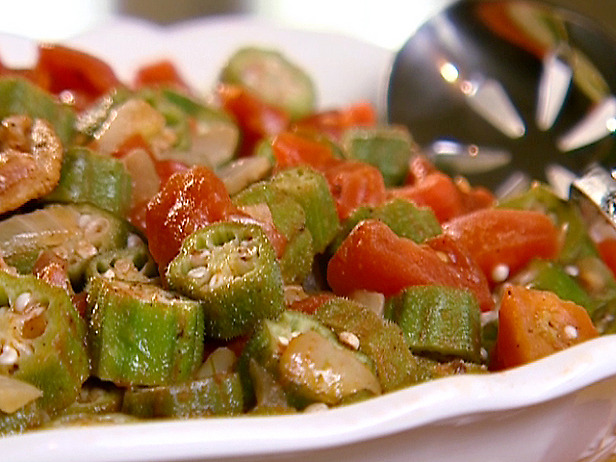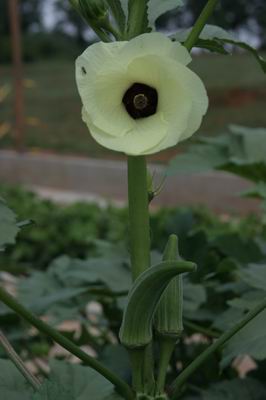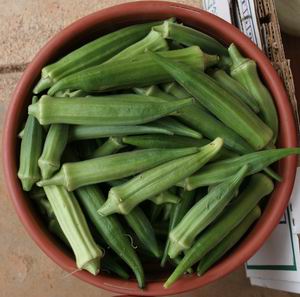|
 This
Okra, Tomatoes and Bacon recipe can be a meal by itself. Mark and
Kathy gave us this recipe after we shared our garden bounty with them. This
Okra, Tomatoes and Bacon recipe can be a meal by itself. Mark and
Kathy gave us this recipe after we shared our garden bounty with them.
INGREDIENTS:
4 slices bacon
1/2 cup chopped onion
1 1/2 pounds fresh okra, washed, stemmed, sliced about 1/2-inch thick
4 large tomatoes, peeled, seeded, and diced
2 teaspoons salt
pepper, to taste
dash crushed red pepper, or to taste
DIRECTIONS:
Fry bacon in a skillet over medium heat until crisp and fat has been
rendered; drain well on paper towels. Crumble bacon and set aside. Add the
chopped onions to the skillet; reduce the heat to low. Cook onions for 10 to
15 minutes, until tender, stirring occasionally. Add the sliced okra,
tomatoes, salt, pepper, and crushed red pepper; stir well and simmer for
about 20 minutes, until okra and tomatoes are just tender. To serve, spoon
okra into a serving dish and sprinkle with the crumbled bacon.
Serves 6.
|
|
 Okra
is native to the Old World tropics (probably West Africa) and has become
established in the wild in some New World tropical areas. It is generally
believed that okra first reached the New World during the days of slave
trafficking. Okra is a popular and important food in Third World tropical
countries. It is widely used in India, Africa and the Middle East, but
almost unknown in Europe and northern North America. Okra is often
known as Lady's Fingers outside of the United States, and gumbo in parts of
the United States and English-speaking Caribbean, based on a corruption of
the Portuguese word "quingombo," which is in turn a corruption of the word "quillobo,"
the word for the plant in some parts of eastern Africa. Okra
is native to the Old World tropics (probably West Africa) and has become
established in the wild in some New World tropical areas. It is generally
believed that okra first reached the New World during the days of slave
trafficking. Okra is a popular and important food in Third World tropical
countries. It is widely used in India, Africa and the Middle East, but
almost unknown in Europe and northern North America. Okra is often
known as Lady's Fingers outside of the United States, and gumbo in parts of
the United States and English-speaking Caribbean, based on a corruption of
the Portuguese word "quingombo," which is in turn a corruption of the word "quillobo,"
the word for the plant in some parts of eastern Africa.
The name "okra" is of West African origin and is cognate with "?Žk?`r?`" in
Igbo, a language spoken in Nigeria. In various Bantu languages, okra is
called "kingombo" or a variant thereof, and this is the origin of its name
in Portuguese, Spanish, Dutch and French. The Arabic "bamyah" is the basis
of the names in Cyprus, the Middle East, the Balkans, Iran, Afghanistan,
Greece, North Africa and Russia. In Southern Asia, its name is usually a
variant of "bhindi" or "vendi".
The species apparently originated in the Ethiopian Highlands, though the
manner of distribution from there is undocumented. The Egyptians and Moors
of the 12th and 13th centuries used the Arab word for the plant, suggesting
that it had come from the east. The plant may thus have been taken across
the Red Sea or the Bab-el-Mandeb strait to the Arabian Peninsula, rather
than north across the Sahara. One of the earliest accounts is by a Spanish
Moor who visited Egypt in 1216, who described the plant under cultivation by
the locals who ate the tender, young pods with meal.
 From
Arabia, the plant spread around the shores of the Mediterranean Sea and
eastward. The lack of a word for okra in the ancient languages of India
suggests that it arrived there in the Common Era. The plant was introduced
to the Americas by ships plying the Atlantic slave trade by 1658, when its
presence was recorded in Brazil. It was further documented in Suriname in
1686. From
Arabia, the plant spread around the shores of the Mediterranean Sea and
eastward. The lack of a word for okra in the ancient languages of India
suggests that it arrived there in the Common Era. The plant was introduced
to the Americas by ships plying the Atlantic slave trade by 1658, when its
presence was recorded in Brazil. It was further documented in Suriname in
1686.
Okra may have been introduced to southeastern North America in the early
18th century. It was being grown as far north as Philadelphia by 1748.
Thomas Jefferson noted that it was well established in Virginia by 1781. It
was commonplace throughout the southern United States by 1800 and the first
mention of different cultivars was in 1806.
-wiki
|
What What What Recipe Box
© REED Technologies |